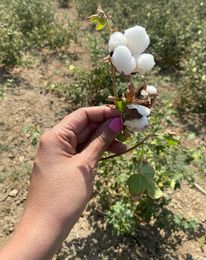One of the greatest things about being a fashion journalist in India is that you are never just one thing. Your stories can take you to glamorous fashion weeks across the world, and they can also take you to the remotest parts of India, allowing you to tell stories of people whose voices have been quietened. Like the farmers of the indigenous kala cotton plant.
Kala cotton is indigenous to Kutch, in Gujarat. It is a fully organic cotton as it is grown without any pesticides or synthetic fertilisers. It is only harvested by rain water, and requires no additional hydration. As it is grown in rough conditions, it is a strong crop, and has a high tolerance for disease and pests. It is naturally coarser than commercial cotton, browner and thicker, and can be used in making gorgeous denim. Like denim, it is breathable and can be worn in the summer or winter.
I found myself on a gruelling research trip to Kutch recently. I spent most of my time at Adesar, a kala cotton farm, speaking to farmers about how and why they do what they do.
The Adesar Vistar Khet Utpadan Producer Company Limited is a collective of around 330 farmers and has been in existence since 2005 (it was registered as a company in 2014). I am meeting Devshi Parmar, currently the MD, at their humble local office. He explains that the major role of a producer group is to mobilise organic farming, and provide organic certification and links to marketplaces.
At Adesar, along with kala cotton, the farmers also grow castor, bajra, moong, and cluster beans (gowar). Both castor and kala cotton are sown in August, and both for eight months, but the demand for castor for oil is much greater, especially from the US, Europe and Australia. The demand for kala cotton is much lower and infrequent, he says.
“In the last two months alone 15-20 groups of visitors have come here from 12-13 countries. No new orders have been placed, everyone has only taken our photos and returned,” Parmar tells me.
His regular orders for kala cotton come from Khamir, a trust that promotes Kutch crafts, another trust Kutch Ji Chhap, and the master weaver Shyamji Valji of Bhujodi.
In 2006, a well-known denim factory got in touch with the Adesar group, and asked for 300-400 metric tonnes (four lakh kilos) of cotton, with organic certification, and in ready bales. They placed an order for two years, but stopped after the 2008 economic crash. The Adesar group had to integrate additional farmers and yet could produce only two lakh kilos for them. After 2008, only 150 farmers remained.
The indigenous kala cotton, despite its fully organic status, finds few takers. It is a short-staple yarn so much thicker than commercial cotton. It is also a small-batch growth, so large-scale production is hard to do.
But its positives are pure magic. It is fully natural. It barely needs any water—it used only 30-35 millimetres of water at the time of sowing—hence grown in August to drink up the rain. As opposed to Bt cotton, a genetically modified pest-resistant cotton that needs watering every 10-12 days, and uses about 600 millimetres of water, that’s 20 times more water than kala cotton.
Kala cotton also requires no capital. Bt cotton requires irrigation technology, pesticides and other farm equipment. So you may make more money growing commercial cotton but you also spend more money. Kala cotton buds are greener, hence sweeter, so wild animals throng here, and thus it supports a healthier ecology, too. Its buds are used to feed organic food to local cows, buffaloes and goats.
Kala cotton needs more takers, more consumers. It also needs a status update: from ‘black cotton’ to ‘white gold’.
X@namratazakaria


